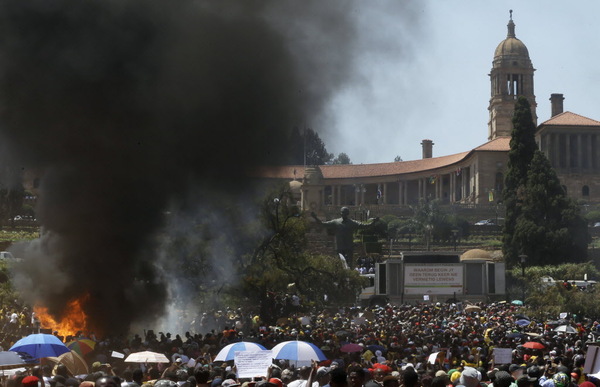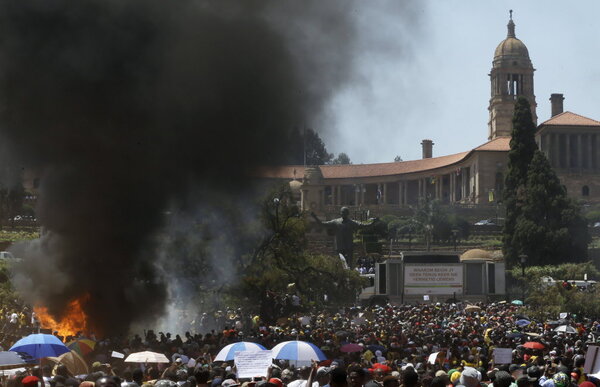.
After meeting with student leaders and university heads, President Jacob Zuma announced Friday afternoon that he would freeze university fee hikes for the coming year, responding to demonstrations that managed in a matter of days to transform a relatively isolated problem — rising college tuition — into a national moral imperative.
For many of the young people who took to the streets this week, however, the victory now seems hollow. Not 15 minutes after the announcement, a cloud of tear gas and a hailstorm of rubber bullets forced the thousands of protesters who had gathered outside Mr. Zuma’s office in Pretoria’s Union Buildings hours earlier to abruptly disperse.
“When we started throwing stones at the police, they call that violence, but is it not violence what our government and our universities are doing to us in their boardrooms?” said Mmangaliso Mkhonta, a student leader and electrical engineering Masters candidate at the University of Johannesburg. “Yes, we’re happy with the fee freeze, but there are many more issues still to come if we want to transform our universities.”
By the time Mr. Mkhonta and his fellow students trudged home Friday evening, ostensibly victorious, the neat boundaries of their movement were suddenly blurrier. For many the issue of university access had transformed into a less focused outpouring of anger and grief over an inability to overcome the poverty their parents’ generation had waged a war of liberation to escape. The president’s announcement seemed to raise far more questions than it answered, leaving uncertain the future of one of the most successful popular protests in recent South African history.
‘We are your children’
The demonstration in Pretoria began calmly Friday morning, as tens of thousands of activists from around South Africa marched along the city’s wide, jacaranda-lined streets, drawing the cheers of onlookers who waved them on from the windows of office buildings and store fronts as they passed. The demonstrators carried placards, both snarky and serious, bearing messages for the president and his higher education minister, shaming them for forgetting the ideals they fought for when they themselves were young activists.
“If Zuma doesn’t pay, why should I?” read one that referred to claims that Zuma used millions of dollars in state funding to build and equip his own house. “Sorry for the inconvenience,” read another, “we are trying to change the world.”
The students said their demands were nothing new or revolutionary: a cut to tuition bills that price-out the vast majority of black South Africans, or saddle them with long term debt in an economy crippled by 25 percent official unemployment.
“We’ve been fighting for years over this issue of access,” says Luyolo Mphithi, a Masters student in politics at the University of the Witwatersrand in Johannesburg. “Every year when they announce fee increases, we protest. But for some reason this year it took off.”
Mr. Mphithi carried with him a vivid yellow placard with a stark admonition: “Police,” it read, “we are your children.”
It proved a telling message. As the protestors gathered on the grounds of the Union Buildings, the atmosphere was, at first festive, with activists blowing vuvuzelas and breaking into renditions of old liberation struggle songs.
But as the morning turned to afternoon, the mood began to shift. A knot of young men on the fringe of the demonstration began overturning porta-potties, then lighting them on fire. As the hours wore on, some pulled down gates that separated activists from the steps of the buildings, where a band of riot police huddled behind plastic shields. The men, their faces bent in anger, lobbed rocks and bottles then cheered wildly as police returned fire with stun grenades and smoke bombs.
“You’re poor like us but still you shoot us,” screamed one student in a yellow shirt bearing the logo of the ruling African National Congress’ Youth League. “Where do you think your kids go to school?”
Other demonstrators, meanwhile, stepped in to diffuse the situation, attempting to force the frontline back with chants of “no more violence” and “stop throwing stones.”
“At moments it felt like I was watching the 1980s over again,” says Sekiba Lekgoathi, the head of the history department at the University of the Witwatersrand, referring to the youth protests that helped to make many black areas of South Africa ungovernable in the dying years of apartheid. “They’re drawing on a long history here, a long protest tradition, and making it their own.”
A momentary victory
The violence also seemed to open fissures in the fragile coalition of students from across the economic, racial and political spectrum who had come together against tuition hikes. As the violence escalated, the crowd’s numbers dwindled. Many of those who stayed behind eventually slouched on the stairs of the Union Buildings, wiping tear gas from their eyes as they awaited Zuma’s address — delivered on live TV from inside the building behind them.
When it came, a brief moment of excitement flickered across the crowd, but it quickly faded.
“How can we see this [fee freeze] as a victory?” asked Thapelo Mhlongo, a student at the Tshwane University of Technology in Pretoria, echoing a sentiment expressed by several students. “We have been waiting for free education since 1994. This is a start, but we are still waiting. We’re still waiting for a lot of other things too.”
Nearly as soon as Zuma went off the air, a group of students made their final surge at the police barricade. Just beyond them towered a massive statue of Nelson Mandela, his arms open and outstretched



